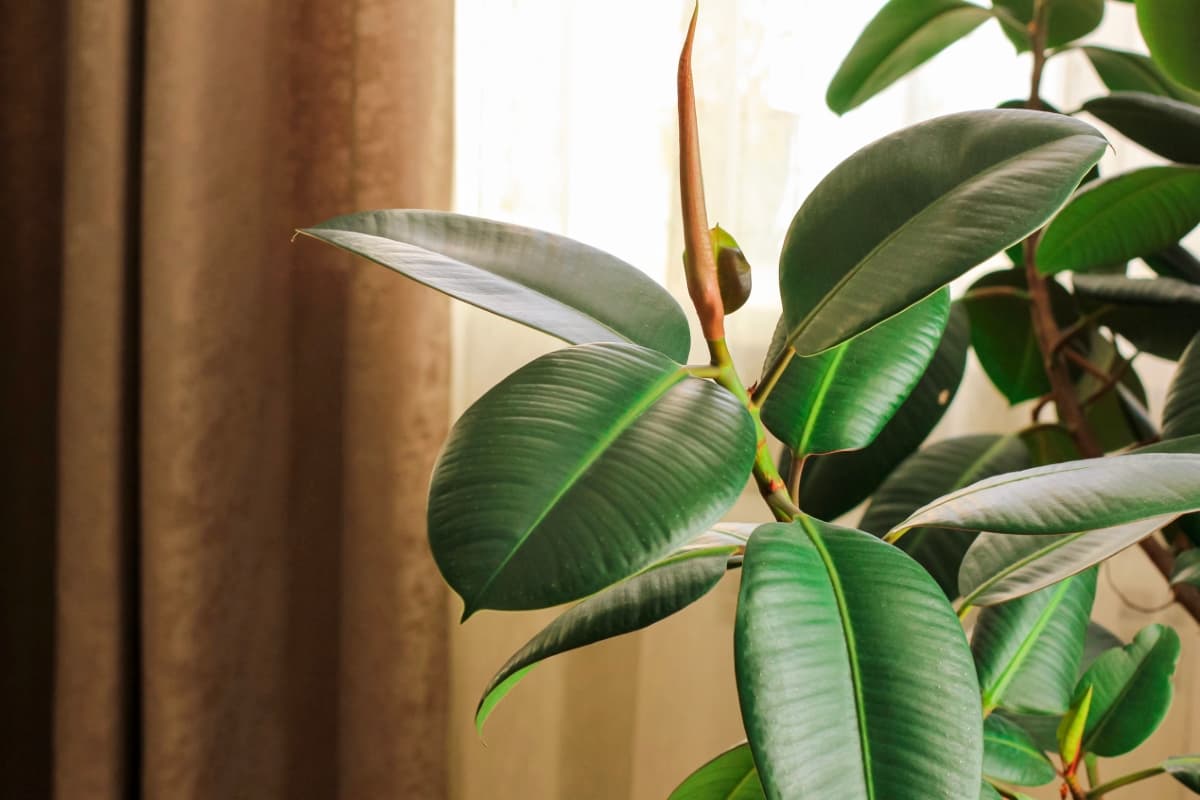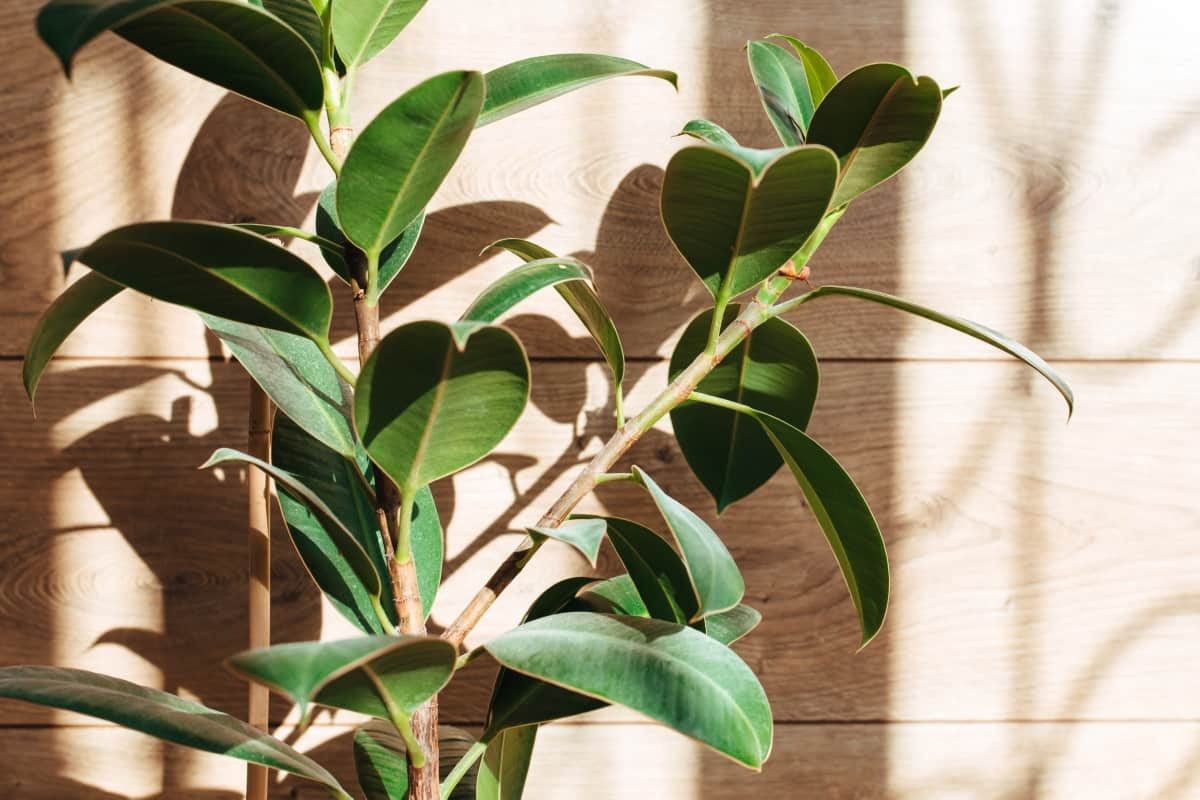Rubber plants, with their glossy leaves and striking appearance, have become the best choice for indoor gardening enthusiasts. If you’re looking to expand your Rubber plant collection or share the joy of growing these beautiful plants with others, understanding the basics of Rubber plant propagation is essential. Propagation is creating new plants from existing ones. There are several methods you can use to propagate rubber plants successfully.

One common method is water propagation, where you place the cutting in water until roots form before transferring it to the soil. Rubber plant propagation in water can be an exciting way to witness root development firsthand. Propagating Rubber plants in the soil mix is another technique that many gardeners prefer.
In this method, you take the cutting and directly plant it into moist soil mixtures specially formulated for propagating houseplants like Rubber plants. When it comes to successful Rubber plant propagation in various environments, there are a few tips worth noting. First and foremost, maintaining optimal temperature and humidity levels during the rooting process greatly enhances success rates.
How to Propagate Rubber Plant: A Step-By-Step Guide
Best Practices for Rooting Rubber Plant Cuttings in Water
When it comes to Rubber plant propagation in water, one of the most popular methods is rooting Rubber plant cuttings in water. This method is not only simple but also highly effective. Choose healthy and mature stems for your cuttings. Look for stems that have at least three leaves and are free from any signs of disease or damage. Using clean scissors, make a clean cut just below a leaf node.
Remove the lower leaves from the cutting to prevent them from rotting in the water. Leave two or three leaves at the top intact, as these will provide energy for new root growth. Fill a clear glass or jar with fresh tap water and place your cutting inside so that about an inch of the stem is submerged. Make sure no leaves touch the water, as this can lead to rotting.
Place your glass or jar near a bright but indirect light source. Change the water every few days to keep it fresh and oxygenated. Patience is key when rooting Rubber plant cuttings in water. It typically takes a few weeks to see roots forming at the base of your cutting. Once you notice well-established roots growing, you can transfer your cutting into the soil if desired.
Soil Propagation Techniques for Rubber Plants
When it comes to propagating Rubber plants, one of the most popular methods is using soil. This technique requires a bit more patience and care compared to water propagation, but it can yield great results. To start, you will need a well-draining potting mix that is rich in organic matter. Choose a pot that contains drainage holes to prevent waterlogging. Before planting your cutting, make sure to prepare the soil by moistening it slightly.
Next, take a healthy stem cutting from your Rubber plant. Make sure it’s about 4-6 inches long and has several nodes on it. Now, create a small hole using your finger or a pencil and gently insert the cutting into it. Press down lightly around the cutting to ensure good contact with the soil. After planting, place your potted cutting in an area with bright, indirect light.
Avoid direct sunlight, as this can scorch young plants. Maintain consistent moisture levels by watering when the top inch of soil feels dry. In just a few weeks, you should start seeing new growth emerging from your planted Rubber plant cutting. Keep caring for it diligently by providing sufficient light and keeping an eye on moisture levels. Remember that every plant is unique and may respond differently to propagation techniques.
Tips for Successful Rubber Plant Propagation in Various Environments
When it comes to propagating Rubber plants from cuttings, success can depend on the environment in which you choose to grow them. First and foremost, temperature is key. The optimal temperature for Rubber plant propagation ranges from 15-27°C. It’s important to find a location that provides consistent warmth throughout the day. In addition to temperature, humidity plays an important role in successful propagation.
In case you missed it: How to Grow and Care for Rubber Plants Indoors: A Beginners Guide

Rubber plants prefer high humidity levels of around 50-60%. If you live in a dry climate or have low humidity indoors, consider using a humidifier or placing your cuttings near a tray filled with water. Lighting conditions also need careful consideration. Place your cuttings near a window where they will receive filtered light, or use artificial grow lights if necessary. Watering is another crucial factor for successful propagation. Make sure not to overwater your Rubber plant cuttings, as this can cause root rot.
Common Mistakes to Avoid when Propagating Rubber Plants
When it comes to propagating Rubber plants, there are a few common mistakes that many people make. One of the biggest errors is not properly preparing the cutting before planting it. It’s important to remove any leaves from the bottom of the cutting and make a clean cut at a 45-degree angle. Another mistake to avoid is overwatering your newly propagated Rubber plant. While it’s crucial to keep the soil moist, too much water causes root rot and hinders growth.
It’s best to let the soil dry out slightly between waterings. In addition, avoid placing your Rubber plant in direct sunlight immediately after propagation. While these plants do enjoy bright light, they can be sensitive during this early stage of growth. Start by placing them in an area with indirect or filtered light until they become more established. Furthermore, using low-quality or incorrect soil can also impede successful propagation. Rubber plants thrive in well-draining soil that retains moisture without becoming waterlogged.
Enhancing Success Rates in Rubber Plant Propagation
When it comes to propagating Rubber plants indoors, there are a few key factors that can greatly enhance your success rates. First and foremost, it’s important to choose healthy parent plants for propagation. Look for mature and disease-free Rubber plants with strong stems and vibrant leaves. This will give your cuttings the best chance of thriving. Next, make sure to take clean and sharp cuttings from the parent plant. Clean cuts reduce the risk of infection and promote faster rooting.
In case you missed it: Black Pepper Varieties in India: Different Types of Black Peppers

To further boost success rates, consider using a rooting hormone when propagating your Rubber plant cuttings. Rooting hormones in Rubber plant propagation contain growth-promoting substances that stimulate root development, increasing the chances of successful propagation. Proper care during root formation is crucial for enhancing success rates as well. Maintain a consistent level of moisture while avoiding overwatering. Providing adequate light levels without exposing the cuttings to direct sunlight is also important.
Exploring Different Methods of Propagating Rubber Plants
One common method is leaf propagation. Take a healthy leaf from a mature Rubber plant and place it in water or soil until roots start to form. Leaf propagation can be a slow process, but it often yields successful results. Another option is air layering. This technique involves making an incision on the stem of the Rubber plant and wrapping it with moist moss or another rooting medium. The wrapped section is then covered with plastic wrap to create a humid environment that encourages root growth.
If you’re feeling more adventurous, you could try using stem cuttings for propagation. Simply cut off a piece of the stem below a node and place it in water or soil until roots develop. Stem cuttings have higher success rates than leaf propagation but require careful attention to watering and humidity levels. Grafting is yet another method worth exploring if you want to propagate variegated Rubber plants. By joining two different plants together, usually through grafting tape or clips, you can combine desirable traits from both varieties into one plant.
Advanced Techniques for Propagating Variegated Rubber Plants
Variegated Rubber plants, with their striking foliage patterns of white and green or yellow and green, are highly sought after by plant enthusiasts. If you’re looking to propagate these beauties, there are a few advanced techniques that can help increase your success rate. One method is air layering, which involves creating a small wound on the stem and surrounding it with moist sphagnum moss or perlite. This encourages roots to form at the wounded area while still attached to the parent plant.
In case you missed it: Best Fertilzer for Black Pepper Plants: Nutrient Management in Black Pepper/Piper Nigrum Farms

Once roots have developed sufficiently, you can cut below the rooted section and pot it up as a new plant. Another technique is using hormone rooting powder or gel when taking a leaf or stem cuttings from variegated Rubber plants. Additionally, temperature control can play a crucial role in propagating variegated Rubber plants. These plants thrive in warm temperatures between 15-27°C, so maintaining consistent warmth throughout the process is important for optimal growth.
Conclusion
Propagating Rubber plants can be a rewarding and fulfilling experience for both beginner and experienced gardeners alike. By understanding the basic principles of propagation and following the step-by-step techniques, you can successfully grow new Rubber plants from water, soil, and cuttings. Experiment with different methods of propagation to find what works best for you. With patience, care, and a little bit of trial and error, you’ll soon have a collection of beautiful Rubber plant offspring that will bring life and greenery into your home or garden.
- Cabbage Seed Germination and Selection
- Broccoli Seed Germination and Selection
- Asparagus Seed Germination and Variety Selection
- Seasonal Flower Gardening: Best Practices for Spring, Summer, Fall, and Winter
- How to Grow Hibiscus from Flower
- Plantation Ideas for Home Decoration: A Beginners Guide
- Flower Garden Designs and Layouts for Beginners
- Planting and Spacing Techniques in Papaya: A Beginner’s Guide
- Growing Gold: Essential Techniques for Planting Pineapples